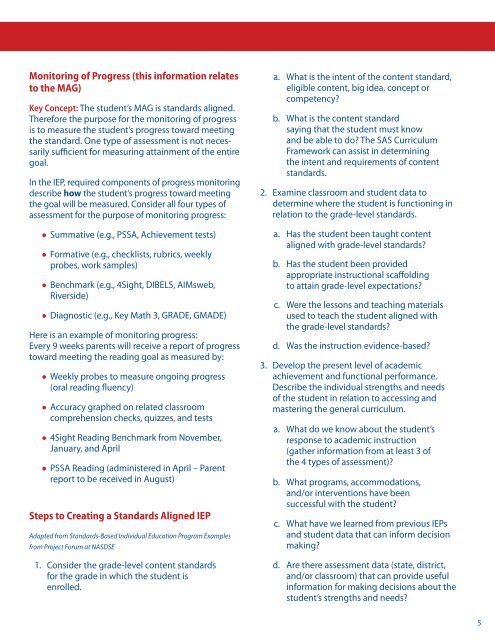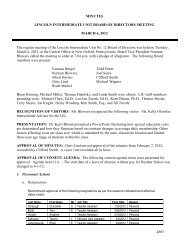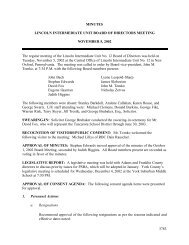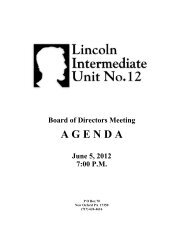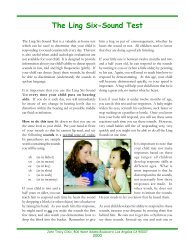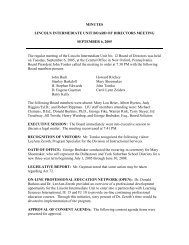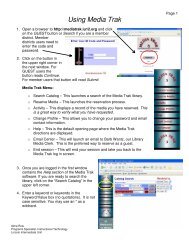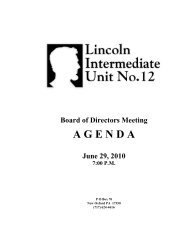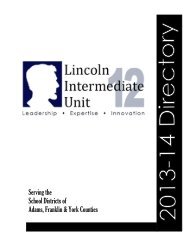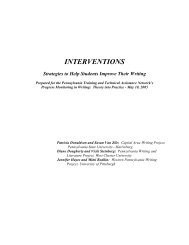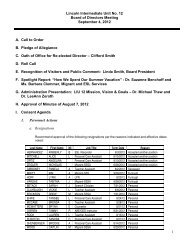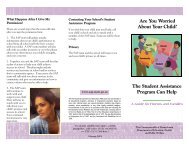WRITING STANDARDS ALIGNED IEPS: - Lincoln Intermediate Unit 12
WRITING STANDARDS ALIGNED IEPS: - Lincoln Intermediate Unit 12
WRITING STANDARDS ALIGNED IEPS: - Lincoln Intermediate Unit 12
Create successful ePaper yourself
Turn your PDF publications into a flip-book with our unique Google optimized e-Paper software.
Monitoring of Progress (this information relates<br />
to the MAG)<br />
Key Concept: The student’s MAG is standards aligned.<br />
Therefore the purpose for the monitoring of progress<br />
is to measure the student’s progress toward meeting<br />
the standard. One type of assessment is not necessarily<br />
sufficient for measuring attainment of the entire<br />
goal.<br />
In the IEP, required components of progress monitoring<br />
describe how the student’s progress toward meeting<br />
the goal will be measured. Consider all four types of<br />
assessment for the purpose of monitoring progress:<br />
• Summative (e.g., PSSA, Achievement tests)<br />
• Formative (e.g., checklists, rubrics, weekly<br />
probes, work samples)<br />
• Benchmark (e.g., 4Sight, DIBELS, AIMsweb,<br />
Riverside)<br />
• Diagnostic (e.g., Key Math 3, GRADE, GMADE)<br />
Here is an example of monitoring progress:<br />
Every 9 weeks parents will receive a report of progress<br />
toward meeting the reading goal as measured by:<br />
• Weekly probes to measure ongoing progress<br />
(oral reading fluency)<br />
• Accuracy graphed on related classroom<br />
comprehension checks, quizzes, and tests<br />
• 4Sight Reading Benchmark from November,<br />
January, and April<br />
• PSSA Reading (administered in April – Parent<br />
report to be received in August)<br />
Steps to Creating a Standards Aligned IEP<br />
Adapted from Standards-Based Individual Education Program Examples<br />
from Project Forum at NASDSE<br />
1. Consider the grade-level content standards<br />
for the grade in which the student is<br />
enrolled.<br />
a. What is the intent of the content standard,<br />
eligible content, big idea, concept or<br />
competency?<br />
b. What is the content standard<br />
saying that the student must know<br />
and be able to do? The SAS Curriculum<br />
Framework can assist in determining<br />
the intent and requirements of content<br />
standards.<br />
2. Examine classroom and student data to<br />
determine where the student is functioning in<br />
relation to the grade-level standards.<br />
a. Has the student been taught content<br />
aligned with grade-level standards?<br />
b. Has the student been provided<br />
appropriate instructional scaffolding<br />
to attain grade-level expectations?<br />
c. Were the lessons and teaching materials<br />
used to teach the student aligned with<br />
the grade-level standards?<br />
d. Was the instruction evidence-based?<br />
3. Develop the present level of academic<br />
achievement and functional performance.<br />
Describe the individual strengths and needs<br />
of the student in relation to accessing and<br />
mastering the general curriculum.<br />
a. What do we know about the student’s<br />
response to academic instruction<br />
(gather information from at least 3 of<br />
the 4 types of assessment)?<br />
b. What programs, accommodations,<br />
and/or interventions have been<br />
successful with the student?<br />
c. What have we learned from previous IEPs<br />
and student data that can inform decision<br />
making?<br />
d. Are there assessment data (state, district,<br />
and/or classroom) that can provide useful<br />
information for making decisions about the<br />
student’s strengths and needs?<br />
5


